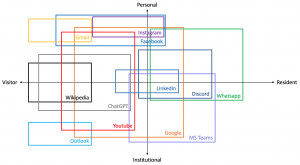The ONL 231 session comes to an end with this topic. In fact, the end is in terms of scheduled meetings, working on specific topics for two weeks, etc. But I believe that my experiences from this course will be reminding this course time and again throughout my academic career ahead. However, I have three major takeaways on top of the experiences from this course after cruising through the days of PBL, they are (i) Community, several (ii) Tools and (iii) Concepts and Practices.
This course introduced me to a community of instructors who are following prescribed pedagogic ways in their teaching. Being located in a place near the north pole, I got acquainted with fantastic individuals from far western, southern and a bit eastern parts of the world. It was very interesting to know about their practice in the educational institutions of those places. In addition, we had a discussion on the socio-economical perspectives related to educational infrastructures. In terms of individuality, some of the intrinsic characteristics of all got my attention. For example, organizing quality, time management, style of research, knowledge about technologies, etc. I find that I lack many different qualities as an instructor. In the future, I earnestly plan to develop those qualities in myself. Last but not least about the community, after attending this course I know a lot of people from whom to seek guidance if I feel any pedagogic problem.
At the beginning of the course, we were instructed to use several tools and services like Google Drive, WordPress, Discord (for our PBL group only) etc. I was very excited that I have knowledge about these tools, and that I can use them very easily. However, as the course progressed, we were tasked with different topics, and my group members and facilitators (both from the group and course) started mentioning lots of different tools. We also ended up using those tools successfully to converge different solutions for the given topics. Though I knew the use of some of the tools, I was amazed at the functions of these tools with free or specific versions for diverse purposes, such as collaboration, moderating meetings with time constraints, summarizing something in an inclusive way, conducting surveys, etc. Specifically, Canva, Mural, Flinga, Prezi and Padlet are the new tools that I got to know in this course, and I will be using these in my future works in addition to Mentimeter, Miro, etc.
The most important takeaway for me from this course is the pedagogic concepts and practices. The noteworthy concepts are open learning, problem-based learning, learning in communities, etc. Specifically, I am mostly carried away by the concept of open learning. Being an individual from a country where education is not free or government funded, I value it most. I believe that education should be available to everyone, and it is also considered by the book everywhere but not in practice. Platforms of open learning with provision for quality open content would produce more competent and educated people for the countries. Talking about the open content, controlling the content arises which would maintain the quality of content so that unreliable or inappropriate learning is accomplished by the open learners. However, with the vast expansion of networks and technology, learning contents are easily accessible by almost everyone which is of great value to me.
Finally, I would like to wrap up my reflection on the final topic of ONL 231. A big congratulations to my PBl group 05 aka Pack of Bad-ass Learners with the mascot Giffy for completing a successful collaborative learning. The group will be in my heart even if I do not express much as an introverted person. Thanks for being there throughout the course and implicitly influencing me for developing more. Moreover, as a group, we produced four products from each of the previous topics. I would store them to reflect those contents in my academic career and spread them among my fellows. I hope the products will be beneficial for their pedagogic development.
